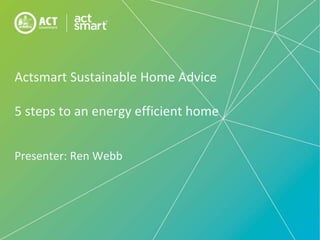5 steps to an energy efficient home
- 1. Actsmart Sustainable Home Advice 5 steps to an energy efficient home Presenter: Ren Webb
- 2. My house ŌĆó Permaculture food production garden ŌĆó Low cost/DIY energy efficiency retrofit - 2 stars to 6.9 stars ŌĆó All-electric home ŌĆō very low usage: $200 per quarter ŌĆó Solar system generating 5 times more energy than we use
- 3. Suite of programs to help support households: ŌĆó Actsmart Sustainable Home Advice ŌĆó Home energy assessments ŌĆó Actsmart Eco Challenge webtool ŌĆó Also promote Heating and hot water upgrade rebates program
- 4. Feel free to ask questions The only silly question is the one that isnŌĆÖt asked
- 5. Why care? An energy efficient house can: ŌĆó save a considerable amount of money and emissions over the life of your home ŌĆó enjoy better thermal comfort & health outcomes ŌĆó enjoy greater energy security ŌĆó improve the re-sale value of your home ŌĆó Make you love where you live
- 6. Annual energy usage - average Canberra home Heating 60% Hot water 16% Electric appliances 15% Lights 4% Cooking 3% Cooling 2% Adapted from Residential energy use 2008, and Residential baseline study 2015
- 7. 1. Are you on the best energy plan? ŌĆó Average middle-income Canberra home spends $3400 a year on energy (electricity and gas 2017/18) ŌĆó 25% discount on usage charges = $600+ per year saving ŌĆō well worth 20 mins on-hold! ŌĆó Review every 6-12 months ŌĆō they do not reward loyalty! www.energymadeeasy.gov.au Energy costs from: Australian Energy Regulator www.aer.gov.au
- 8. 2. Er...do you know your EER (Energy Efficiency Rating)? Improve the thermal performance of your home: ŌĆó Check your contract of sale for the EER report. ŌĆó Implement recommendations ŌĆó 2 stars to 6+ stars for under $4000 possible with DIY
- 9. Have you draught proofed your home? ŌĆó Best ŌĆśbang-for-buckŌĆÖ improvement ŌĆó Affordable, easy and makes a big difference ŌĆó Website, DIY videos, workshops
- 10. Does your insulation need upgrading? ŌĆó Ceiling R5 (25cm thick), walls R2.8, underfloor R2 ŌĆó Reduces heating and cooling costs and improves well-being
- 11. Are your windows well-dressed? ŌĆó Heavy drapes and pelmets and or thermal blinds ŌĆó Shade windows, walls, and hard surfaces around your home - summer
- 12. Are you running a tight-ship? ŌĆó Opening and closing curtains ŌĆó Closing internal doors, curtains in openings without doors ŌĆó Temperature settingsŌĆ” ŌĆó Solar passive = active operators
- 13. 3. Could you save with efficient electric appliances? Heating ŌĆó Biggest cost = biggest opportunity ŌĆó Split system ACs ŌĆō up to 600% efficiency!
- 14. 50m2 living area, heating load 18738 MJ/per year. Calculated at 21.7c per kWh for electricity and 3.2c per MJ for gas. $1,133 $802 $709 $342 $241 $54 $35 $0 $200 $400 $600 $800 $1,000 $1,200 Electric element heaters Old gas flued wall heater 5 star gas flued wall heater 2.5 star reverse cycle split system 5.5 star reverse cycle split system Approximate annual cost to heat a 50m2 living area in Canberra Additional Cooling
- 15. Hot water ŌĆó Behaviour change ŌĆó Low-flow showerhead ŌĆó Upgrade to a heat-pump ŌĆó Got solar PV, use hot water to store energy
- 16. ŌĆó From 2020, gas will make-up 20% of the ACTs emissions ŌĆó $300ish per year supply charge and prices rising ŌĆó New-build all electric home - $5000 extra up-front for $1600 per year saving (with 5kW solar PV) compared to house with gas 4. Can you get off gas?
- 17. ŌĆó If you have a sunny roof install some! ŌĆó Systems are cheap but feed-in-tariffs are low ŌĆó Secret - self-consumption 5. Can you install Solar panels? System size (panels) 2 kW (8) 3 kW (12) 4 kW (16) 5 kW (20) 7 kW (28) 10 kW (40) Cost (total out-of- pocket) $3000 - $4,500 $3,500 - $5000 $4000 - $6000 $5000 - $8000 $6,500 - $10,000 $10,000 - $14000 Typical costs ŌĆō guide only
- 19. ŌĆó With 65% self-consumption (home during the day): typical payback 3-5 years (20-25% returns) ŌĆó With 20% self-consumption (shout-out to all the 9-5ers): typical payback 6-8 years (12-15% return) ŌĆó Load-shift usage, convert to all-electric home to maximise benefit Solar panels Figures from: www.solarquotes.com.au/solar101.html
- 20. Evidence suggests most people do not follow through! ŌĆó Information is not necessarily the key barrier ŌĆó Write down 3 changes that you would like to make and the main benefit you can see for each ŌĆó When would like to have made it by? ŌĆó Would it be ok if I gave you call you after the last date to see how you went and whether you need any support?
- 21. Thank you Come to an evening workshop to learn moreŌĆ” Actsmart Sustainable Home Advice Phone: 1300 141 777 Email: actsmartadvice@act.gov.au Resources www.actsmart.gov.au Your home technical manual 5th edition 2013 ŌĆśLikeŌĆÖ @SustainableCBR




















